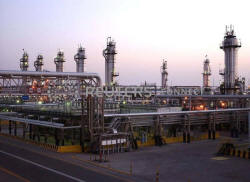Oil prices rebound more than 2% after plunge on Trump's tariff vow
 Send a link to a friend
Send a link to a friend
 [August 02, 2019] By
Noah Browning [August 02, 2019] By
Noah Browning
LONDON (Reuters) - Oil prices rose around
2% on Friday, regaining ground after their biggest falls in years on
U.S. President Donald Trump's threat to impose more tariffs on Chinese
imports.
The move, due to take effect on Sept. 1, would intensify a trade war
between the world's top two economies and crude consumers that has
disrupted global supply chains and roiled financial markets.
Brent crude futures <LCOc1> slumped more than 7% on Thursday, their
steepest drop in more than three years. U.S. West Texas Intermediate (WTI)
crude futures <CLc1> fell nearly 8% to post their biggest drop in more
than four years.
This ended a fragile rally built on steady drawdowns in U.S. inventories
even though global demand looked shaky due to the trade dispute.

Brent futures rose $1.60, or 2.64%, to $62.10 a barrel by 1045 GMT on
Friday. WTI futures gained $1.25, or 2.32%, to $55.20 a barrel.
"Given the latest turn in U.S.-Sino trade relations, sustaining this
uplift may be subject to how China chooses to respond to President
Trumpís new tariff initiative", Harry Tchilinguirian, global oil
strategist at BNP Paribas in London, told the Reuters Global Oil Forum.
"The rise in oil prices may be simply the result of a technical bounce
back from an oversold close yesterday".
Trump said on Thursday he would impose a 10% tariff on $300 billion of
Chinese imports and could raise tariffs further if China's President Xi
Jinping fails to move more quickly to strike a trade deal.
[to top of second column] |

A view shows Saudi Aramco's Abqaiq oil facility in eastern Saudi
Arabia in this undated handout photo. Saudi Aramco/Handout via
REUTERS

The announcement extends Trump's tariffs to nearly all of China's imports into
the United States.
China warned it would not accept any "intimidation or blackmail" and pledged
countermeasures should the tariffs go into effect.
The U.S. economy expanded by 2.1% in the second quarter, government data showed
on July 26, which beat economists' expectations, though it was lower than first
quarter growth.
Still, there are some signs of the economic toll of the trade dispute between
the United States and China, which this week reported slowing manufacturing
activity in July.
U.S. manufacturing activity also slipped last month, dropping to a near
three-year low, and construction spending fell in June as investment in private
construction projects tumbled to its lowest level in 1-1/2 years, data showed on
Thursday.
(GRAPHIC - Daily closes for Brent, U.S. crude in 2019 png: https://tmsnrt.rs/2yHHep7)
(Additional reporting by Aaron Sheldrick; Editing by Kirsten Donovan and Jane
merriman)
[© 2019 Thomson Reuters. All rights
reserved.] Copyright 2019 Reuters. All rights reserved. This material may not be published,
broadcast, rewritten or redistributed.
Thompson Reuters is solely responsible for this content.
 |